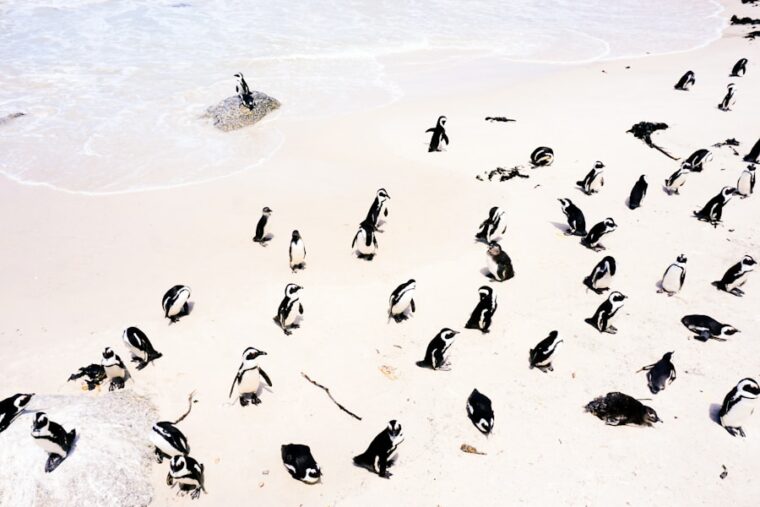The Falkland Islands, located in the South Atlantic Ocean, are a remote and beautiful archipelago known for their stunning landscapes, rich wildlife, and fascinating history. The islands are a British Overseas Territory, and their unique blend of British and South American influences makes them a truly one-of-a-kind destination. With a population of just over 3,000 people, the Falkland Islands offer a peaceful and unspoiled environment for visitors to explore. Whether you’re interested in wildlife watching, outdoor adventures, or learning about the islands’ history and culture, the Falkland Islands have something to offer every traveler.
The Falkland Islands are made up of two main islands, East Falkland and West Falkland, as well as over 700 smaller islands and islets. The capital city, Stanley, is located on East Falkland and is the main hub for tourism and commerce in the archipelago. The islands’ rugged coastline is dotted with beautiful beaches, rocky cliffs, and sheltered bays, while the interior is characterized by rolling hills, peat bogs, and expansive grasslands. The islands’ remote location and pristine natural environment make them a haven for wildlife, with abundant opportunities for birdwatching, seal and sea lion spotting, and even whale watching during the right season.
How to Get to the Falkland Islands
Getting to the Falkland Islands is an adventure in itself, as the archipelago is located over 300 miles east of the southern tip of South America. The most common way to reach the islands is by air, with regular flights departing from Santiago, Chile and Punta Arenas, Chile. The flight from Santiago takes around 5 hours, while the flight from Punta Arenas takes just over 2 hours. There are also occasional flights from other South American cities such as Rio Gallegos, Argentina and Montevideo, Uruguay.
For those seeking a more adventurous journey, it is also possible to reach the Falkland Islands by sea. Several cruise lines offer expeditions to the islands, departing from ports in South America such as Ushuaia, Argentina and Punta Arenas, Chile. These cruises typically include stops at other remote and scenic destinations in the region, such as South Georgia and the Antarctic Peninsula. Once you arrive in the Falkland Islands, transportation around the islands is primarily by car or 4×4 vehicle, as there are limited public transportation options available.
Top Attractions and Activities in the Falkland Islands
The Falkland Islands offer a wide range of attractions and activities for visitors to enjoy. One of the most popular activities is wildlife watching, with opportunities to see penguins, seals, sea lions, and a variety of bird species including albatrosses, petrels, and cormorants. Several species of penguins can be found on the islands, including Gentoo, Magellanic, and Rockhopper penguins. Many visitors also enjoy exploring the islands’ rugged coastline and beautiful beaches, which offer opportunities for beachcombing, photography, and relaxation.
For those interested in history and culture, the Falkland Islands have several fascinating sites to explore. The capital city of Stanley is home to several museums and historical landmarks, including the Falkland Islands Museum and National Trust, which offers exhibits on the islands’ natural history, maritime heritage, and military history. Visitors can also explore historic sites such as the 1982 Liberation Memorial and Government House, which serves as the official residence of the Governor of the Falkland Islands. Outdoor enthusiasts will find plenty of opportunities for hiking, fishing, and boating in the islands’ pristine natural environment.
Wildlife and Nature in the Falkland Islands
The Falkland Islands are renowned for their rich wildlife and unspoiled natural environment. The islands are home to several species of penguins, including Gentoo, Magellanic, Rockhopper, and King penguins. Visitors can observe these charming birds in their natural habitat at several locations around the islands, including Volunteer Point on East Falkland and New Island in the West Falklands. The islands are also home to large colonies of albatrosses, petrels, cormorants, and other seabirds, making them a paradise for birdwatchers.
In addition to birdwatching opportunities, the Falkland Islands offer excellent chances to see marine mammals such as seals and sea lions. Several species of seals can be found on the islands, including Southern elephant seals and South American fur seals. Sea lions are also commonly spotted along the islands’ rocky coastline. For those interested in marine life, the waters around the Falkland Islands are home to a variety of fish species as well as dolphins and whales. Visitors can take boat tours or go fishing to experience these marine wonders up close.
The islands’ rugged landscapes and diverse ecosystems provide ample opportunities for outdoor adventures such as hiking, fishing, and boating. The islands’ interior is characterized by rolling hills, peat bogs, and expansive grasslands that are home to a variety of plant species. Visitors can explore these unique landscapes on foot or by 4×4 vehicle, taking in breathtaking views of the islands’ coastline and interior. Fishing enthusiasts will find ample opportunities to catch trout and other freshwater fish in the islands’ rivers and streams.
Cultural and Historical Sites in the Falkland Islands
The Falkland Islands have a rich history that is reflected in their cultural and historical sites. The capital city of Stanley is home to several museums and landmarks that offer insight into the islands’ past. The Falkland Islands Museum and National Trust is a must-visit for those interested in learning about the islands’ natural history, maritime heritage, and military history. The museum’s exhibits include artifacts from early settlers, whalers, and military conflicts that have shaped the islands’ history.
Visitors can also explore historic sites such as Government House, which serves as the official residence of the Governor of the Falkland Islands. The building’s distinctive architecture reflects its colonial heritage and offers a glimpse into the islands’ past as a British Overseas Territory. Another important historical site is the 1982 Liberation Memorial, which commemorates the lives lost during the Falklands War between Argentina and the United Kingdom. The memorial serves as a reminder of the islands’ turbulent past and their ongoing struggle for sovereignty.
In addition to their historical significance, the Falkland Islands also have a vibrant cultural scene that reflects their unique blend of British and South American influences. Visitors can experience this cultural diversity through local events such as traditional music performances, art exhibitions, and craft fairs. The islands’ small but close-knit community is known for its warm hospitality and friendly demeanor towards visitors.
Where to Stay and Eat in the Falkland Islands
Accommodations in the Falkland Islands range from cozy bed-and-breakfasts to comfortable hotels with modern amenities. The capital city of Stanley has several options for lodging, including guesthouses and boutique hotels that offer personalized service and comfortable accommodations. Visitors can also find accommodations in more remote areas of the islands such as Pebble Island or Sea Lion Island, where they can enjoy a peaceful retreat surrounded by nature.
Dining options in the Falkland Islands include a variety of restaurants and cafes that serve fresh seafood, traditional British fare, and international cuisine. Many establishments source their ingredients locally, offering visitors a taste of the islands’ unique culinary traditions. Seafood lovers will find plenty to enjoy in dishes such as fresh fish and chips or seafood chowder made with locally caught ingredients. Those looking for a taste of home can also find familiar favorites such as roast beef or shepherd’s pie.
Tips for Traveling in the Falkland Islands
When traveling to the Falkland Islands, it’s important to be prepared for their remote location and unique environment. The islands have a cool maritime climate with unpredictable weather patterns, so visitors should pack layers and be prepared for sudden changes in temperature. It’s also important to bring sturdy footwear suitable for walking on uneven terrain and waterproof clothing for outdoor activities.
Visitors should also be mindful of local customs and etiquette when interacting with residents of the Falkland Islands. The islands have a small but close-knit community where politeness and respect are highly valued. It’s important to be considerate of local customs and traditions when visiting cultural or historical sites, as well as when interacting with residents in public spaces.
Finally, it’s important to be mindful of environmental conservation when visiting the Falkland Islands. The islands’ pristine natural environment is home to a diverse array of wildlife that should be respected and protected. Visitors should follow guidelines for wildlife watching and outdoor activities to minimize their impact on local ecosystems. By being mindful of these tips for traveling in the Falkland Islands, visitors can ensure a memorable and respectful experience in this unique destination.


